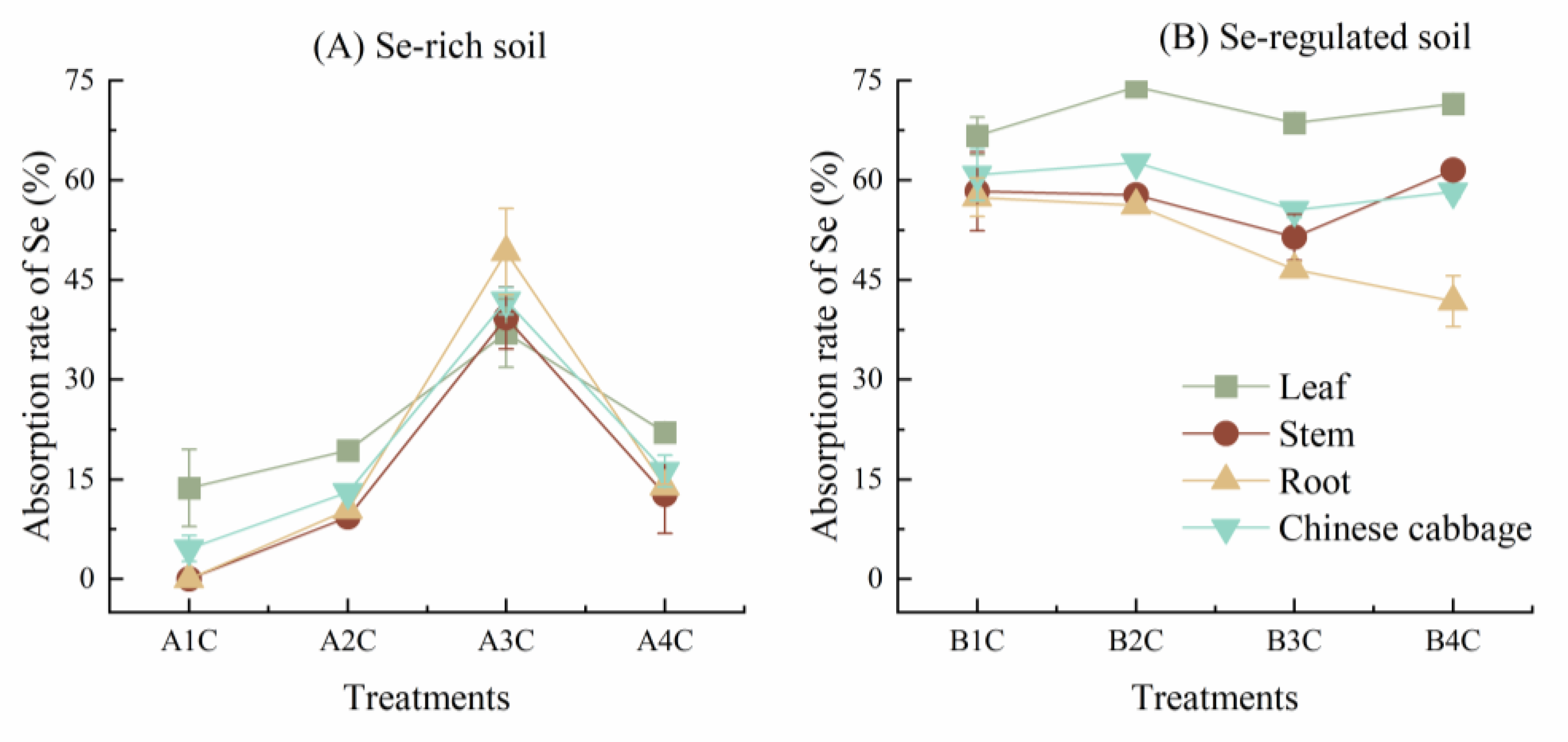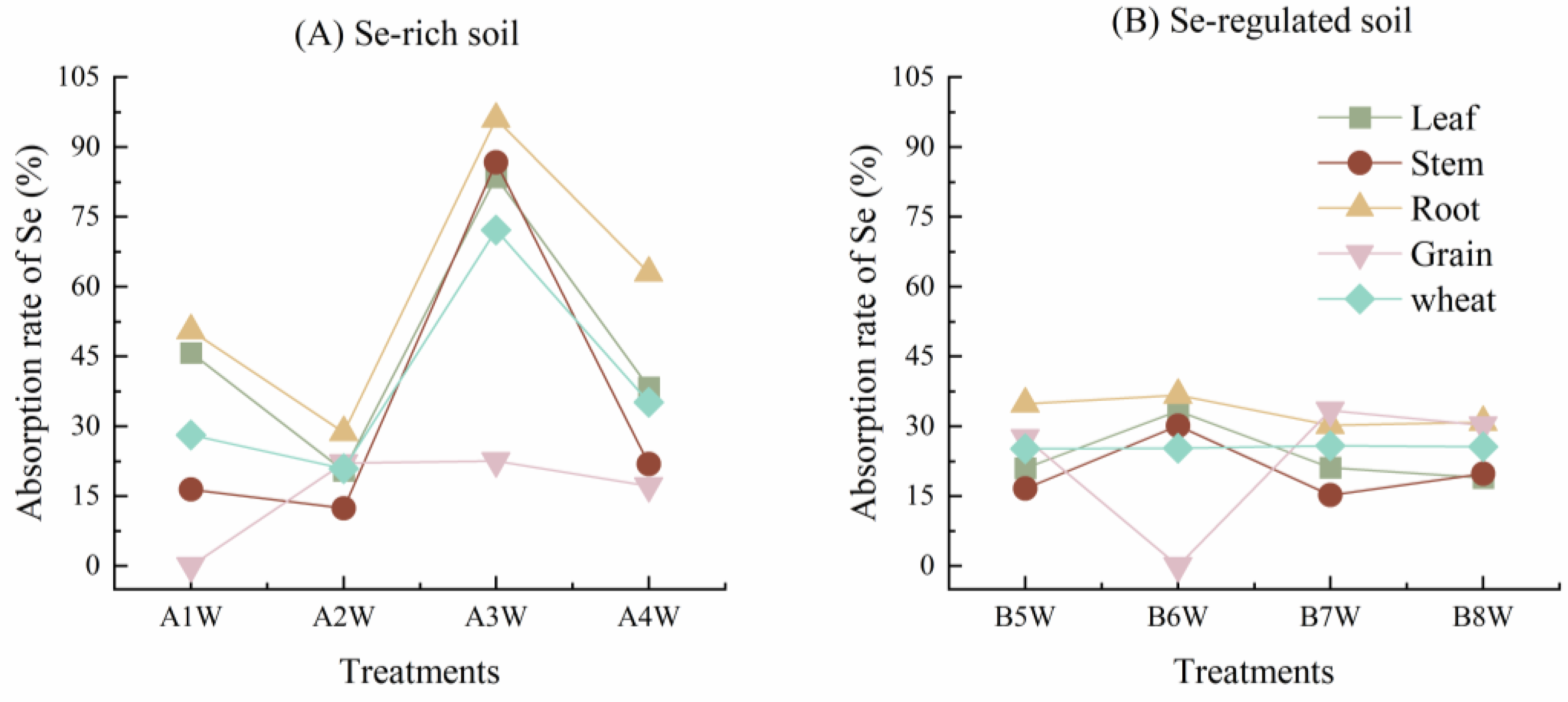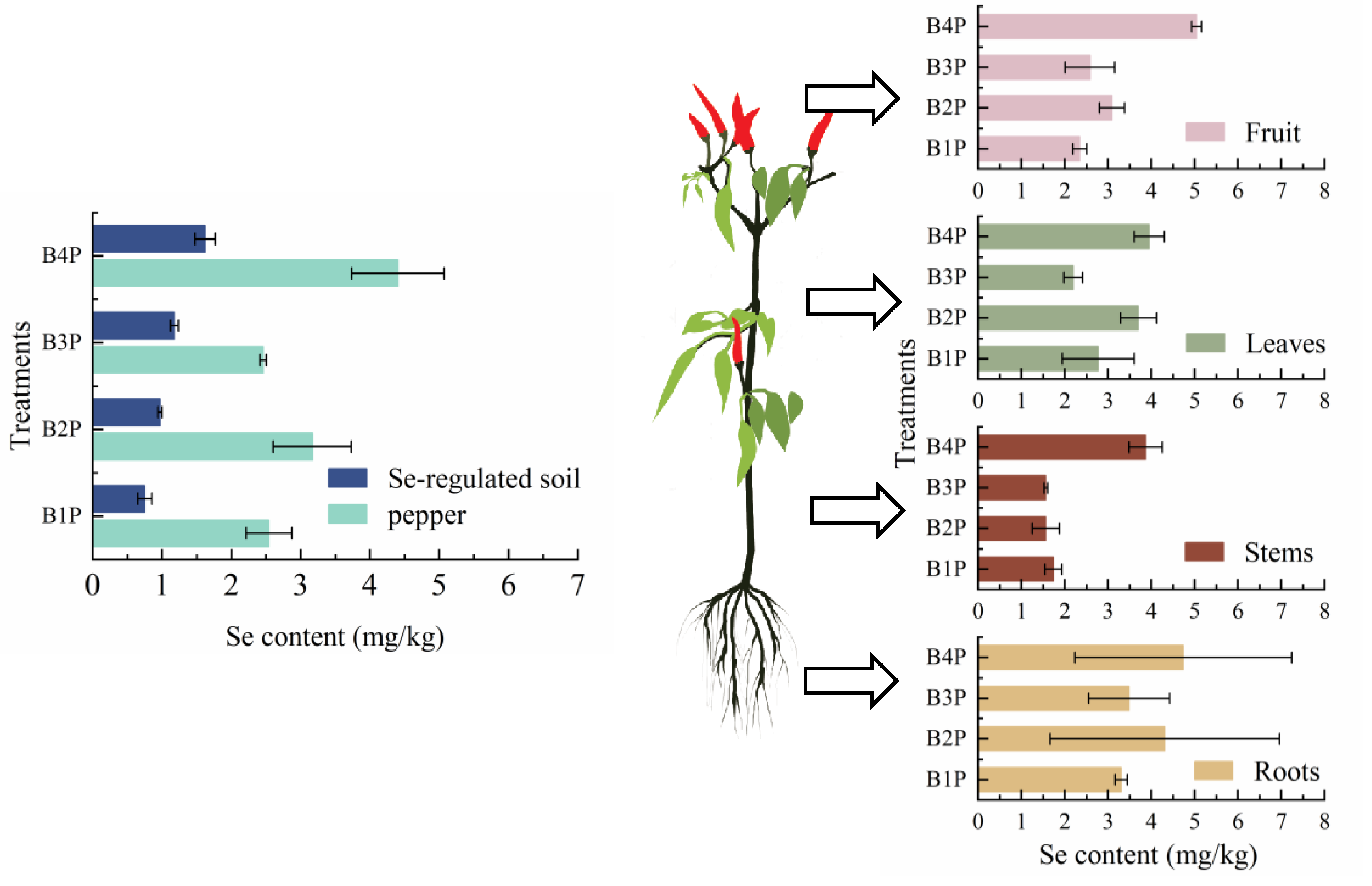Study on the Migration and Accumulation of Selenium between Soil and Vegetations
Abstract
:1. Introduction
2. Materials and Methods
2.1. Study Area
2.2. Experimental Material
2.3. Experimental Design
2.4. Sample Collection and Indicator Determination
2.5. Data Analysis
3. Results
3.1. Uptake and Utilization of Se by Chinese Cabbage
3.1.1. Se Content of Chinese Cabbage in Soils with Different Se Content
3.1.2. Se Content of Chinese Cabbage Organs in Different Se Content Soils
3.1.3. Se enrichment Capacity of Chinese Cabbage for Soil Se
3.2. Uptake and Utilization of Se by Wheat
3.2.1. Se Content of Wheat in Soils with Different Se Content
3.2.2. Se Content of Wheat Organs in Different Se Content Soils
3.2.3. Se Enrichment Capacity in Organs of Wheat
3.3. Uptake and Utilization of Se by Pepper
3.3.1. Se Content of Pepper in Soils with Different Se Content
3.3.2. Se Enrichment Capacity in Organs of Pepper
4. Discussion
4.1. Effect of Soil Se Content on the Se Accumulation of Vegetations
4.2. Se Enrichment Capacity of Different Organs of Vegetations
5. Conclusions
Author Contributions
Funding
Institutional Review Board Statement
Informed Consent Statement
Data Availability Statement
Acknowledgments
Conflicts of Interest
References
- Zhu, Y.G.; Elizabeth, A.H.P.; Zhao, F.J.; Paul, N.W.; Andrew, A.M. Selenium in higher plants: Understanding mechanisms for biofortification and phytoremediation. Trends Plant Sci. 2009, 14, 436–442. [Google Scholar] [CrossRef]
- Vinceti, M.; Filippini, T.; Wise, L.A. Environmental Selenium and Human Health: An Update. Curr. Environ. Health Rep. 2018, 5, 464–485. [Google Scholar] [CrossRef]
- Song, T.J.; Su, X.S.; He, J.; Liang, Y.K.; Zhou, T.; Liu, C. Selenium (Se) uptake and dynamic changes of Se content in the soil-plant systems. Environ. Sci. Pollut. Res. Int. 2018, 25, 34343–34350. [Google Scholar] [CrossRef]
- Qiao, H.; Yin, J.M.; Jiang, F.; Yuan, H.L.; Tan, W.M. Se-enrichment characteristics of Enterobacter mori and its Se strengthening effect on corn grain. Trans. Chin. Soc. Agric. Eng. 2018, 34, 284–290. [Google Scholar]
- Wesselink, E.; Koekkoek, W.A.C.; Grefte, S.; Witkamp, R.F.; Van Zanten, A.R.H. Feeding mitochondria: Potential role of nutritional components to improve critical illness convalescence. Clin. Nutr. 2019, 38, 982–995. [Google Scholar] [CrossRef] [Green Version]
- Jones, G.D.; Droz, B.; Greve, P.; Gottschalk, P.; Poffet, D.; Mcgrath, S.P.; Seneviratne, S.I.; Smith, P.; Winkel, L.H.E. Selenium deficiency risk predicted to increase under future climate change. Proc. Natl. Acad. Sci. USA 2017, 114, 2848–2853. [Google Scholar] [CrossRef] [Green Version]
- Joseph, C.A.; Peter, R.H. Selenium, Selenoproteins, and Immunity. Nutrients 2018, 10, 1203. [Google Scholar]
- Ismael, M.A.; Elyamine, A.M.; Moussa, M.G.; Cai, M.; Zhao, X.; Hu, C. Cadmium in plants: Uptake, toxicity, and its interactions with selenium fertilizers. Met. Integr. Biometal Sci. 2019, 11, 255–277. [Google Scholar] [CrossRef]
- Schomburg, L. Selenium, selenoproteins and the thyroid gland: Interactions in health and disease. Nat. Rev. Endocrinol. 2011, 8, 160–171. [Google Scholar] [CrossRef]
- Zhao, X.; Hogenkamp, A.; Li, X.; Chen, H.; Garssen, J.; Knippels, L.M.J. Role of selenium in IgE mediated soybean allergy development. Crit. Rev. Food Sci. Nutr. 2022, 20, 1–9. [Google Scholar] [CrossRef]
- Zhu, K.; Yang, S.; Li, T.; Huang, X.; Dong, Y.; Wang, P.; Huang, J. Advances in the Study of the Mechanism by Which Selenium and Selenoproteins Boost Immunity to Prevent Food Allergies. Nutrients 2022, 14, 3133. [Google Scholar] [CrossRef] [PubMed]
- Natasha; Shahid, M.; Niazi, N.K.; Khalid, S.; Murtaza, B.; Bibi, I.; Rashid, M.I. A critical review of selenium biogeochemical behavior in the soil-plant system with an inference to human health. Environ. Pollut. 2018, 234, 915–934. [Google Scholar] [CrossRef] [PubMed]
- Xu, W. Bio-availability of Selenium and Its Absorption for Plants. Anhui Agric. Sci. Bull. 2009, 15, 46–47+67. [Google Scholar]
- Anjum, K.; Kalpana, P. Bioaccessibility of selenium, selenomethionine and selenocysteine from foods and influence of heat processing on the same. Food Chem. 2016, 194, 1293–1299. [Google Scholar]
- Thiry, C.; Ruttens, A.; De Temmerman, L.; Schneider, Y.J.; Pussemier, L. Current knowledge in species-related bioavailability of selenium in food. Food Chem. 2012, 130, 767–784. [Google Scholar] [CrossRef]
- Wang, M.; Li, B.; Li, S.; Song, Z.; Kong, F.; Zhang, X. Selenium in Wheat from Farming to Food. J. Agric. Food Chem. 2021, 69, 15458–15467. [Google Scholar] [CrossRef]
- Liu, Q.; Tian, X.; Shi, Y.X. Effect of exogenous Se mineral powder on the accumulation of Se and the absorption of mineral elements in maize. J. Plant Nutr. Fertil. 2016, 22, 403–409. [Google Scholar]
- Liu, Y.X.; Huang, S.H.; Jiang, Z.H.; Wang, Y.Z.; Zhang, Z.M. Selenium Biofortification Modulates Plant Growth, Microelement and Heavy Metal Concentrations, Selenium Uptake, and Accumulation in Black-Grained Wheat. Front. Plant Sci. 2021, 12, 748523. [Google Scholar] [CrossRef]
- Bañuelos, G.S.; Mayland, H.F. Absorption and Distribution of Selenium in Animals Consuming Canola Grown for Selenium Phytoremediation. Ecotoxicol. Environ. Saf. 2000, 46, 322–328. [Google Scholar] [CrossRef]
- Ayako, Y.; Yasuko, O.; Yasumi, A.; Yasumitsu, O. Comparison of Selenium Metabolism in Three Brassicaceae Plants. J. Health Sci. 2010, 56, 699–704. [Google Scholar]
- Zhang, X.X.; Lv, A.Q.; Cheng, C.; Liu, S.; Li, A.N. Study on Selenium Content in Peppers from Different Regions. Anhui Agric. Sci. Bull. 2021, 27, 58–59+125. [Google Scholar]
- Mathers, A.W.; Young, S.D.; McGrath, S.P.; Zhao, F.J.; Crout, N.M.J.; Bailey, E.H. Determining the fate of selenium in Wheat biofortification: An isotopically labelled field trial study. Plant Soil 2017, 420, 61–77. [Google Scholar] [CrossRef] [Green Version]
- Boldrin, P.F.; Faquin, V.; Clemente, A.D.C.S.; De Andrade, T.; Guilherme, L.R.G. Genotypic Variation and Biofortification with Selenium in Brazilian Wheat Cultivars. J. Environ. Qual. 2018, 47, 1371–1379. [Google Scholar] [CrossRef] [PubMed]
- Williams Araújo do Nascimento, C.; Bruno Viera da Silva, F.; de Brito Fabricio Neta, A.; Miranda Biondi, C.; Aparecida da Silva Lins, S.; Bezerra de Almeida Júnior, A.; Preston, W. Geopedology-climate interactions govern the spatial distribution of selenium in the soils: A case study in northeastern Brazil. Geoderma 2021, 399, 115119. [Google Scholar] [CrossRef]
- Reynolds, R.J.B.; Pilon-Smits, E.A. Plant selenium hyperaccumulation- Ecological effects and potential implications for selenium cycling and community structure. BBA-Gen. Subj. 2018, 1862, 2372–2382. [Google Scholar] [CrossRef]
- Favorito, J.E.; Grossl, P.R.; Davis, T.Z.; Eick, M.J.; Hankes, N. Soil-plant-animal relationships and geochemistry of selenium in the Western Phosphate Resource Area (United States): A review. Chemosphere 2020, 266, 128959. [Google Scholar] [CrossRef]
- Hu, Q.H.; Pan, G.X.; An, X.X.; Zhu, J.C.; Ding, R.X. Study on selenium relative bioavailability of Se-enriched tea and its effect on rat phagocytic cell function. J. Nanjing Agric. Univ. 2000, 14, 89–92. [Google Scholar]
- Li, M.L.; Yang, B.Y.; Xu, K.Y.; Zheng, D.S.; Tian, J.C. Distribution of Se in the rocks, soil, water and crops in Enshi County, China. Appl. Geochem. 2020, 122, 104707. [Google Scholar] [CrossRef]
- Gao, J.; Liu, Y.; Huang, Y.; Lin, Z.Q.; Gary, S.B.; Michael, H.L.; Yin, X.B. Daily selenium intake in a moderate selenium deficiency area of Suzhou, China. Food Chem. 2011, 126, 1088–1093. [Google Scholar] [CrossRef]
- Xie, W.W. Comparative Study on Selenium Enrichment Ability among Different Brassica Vegetables; Southwest University: Chongqing, China, 2016. [Google Scholar]
- Ngigi, P.B.; Lachat, C.; Masinde, P.W.; Du Laing, G. Agronomic biofortification of maize and beans in Kenya through selenium fertilization. Environ. Geochem. Health 2019, 41, 2577–2591. [Google Scholar] [CrossRef]
- Dong, Z.; Xiao, Y.; Wu, H. Selenium accumulation, speciation, and its effect on nutritive value of Flammulina velutipes (Golden needle mushroom). Food Chem. 2020, 350, 128667. [Google Scholar] [CrossRef] [PubMed]
- Li, T.; Sun, F.Y.; Gong, P.; Wang, A.; Yuan, L.X.; Yin, X.B. Effects of nano-selenium fertilization on selenium concentration of Wheat grains and quality-related traits. J. Plant Nutr. Fertil. 2017, 23, 427–433. [Google Scholar]
- Liu, H.L.; Wang, X.Q.; Zhang, B.M.; Han, Z.X.; Wang, W.; Chi, Q.H.; Zhou, J.; Nie, L.S.; Xu, S.F.; Liu, D.S.; et al. Concentration and distribution of selenium in soils of mainland China, and implications for human health. J. Geochem. Explor. 2021, 220, 106654. [Google Scholar] [CrossRef]
- Wang, Q.X.; Liu, Q.Q.; Liu, H.L.; Hu, Q.H.; Wu, H.; Wang, W. Key elements and human health: Is China’s arable land selenium-deficient? Earth Sci. Front. 2021, 28, 412–423. [Google Scholar]
- Gu, W.; Zhou, B.; Huang, L.C.; Wang, W.; Zhu, Y.B.; Zhao, D.; Fang, Y.Q.; Zhang, R.H. A research on the dietary intake of selenium among rural and urban residents. Prev. Med. 2014, 26, 977–981. [Google Scholar]
- Liu, N.; Wang, M.; Zhou, F.; Zhai, H.; Qi, M.X.; Liu, Y.; Li, Y.N.; Zhang, N.C.; Ma, Y.Z.; Huang, J.; et al. Selenium bioavailability in the soil-Wheat system and its dominant influential factors: A field study in Shaanxi province, China. Sci. Total Environ. 2021, 770, 144664. [Google Scholar] [CrossRef]
- Zhang, S.X.; Li, B.; Luo, K.L. Differences of selenium and other trace elements abundances between the Kaschin-Beck disease area and nearby non-Kaschin-Beck disease area, Shaanxi Province, China. Food Chem. 2021, 373, 131481. [Google Scholar] [CrossRef]
- Ren, R.; Wang, M.X.; Chen, J.P.; Chao, X.; Wang, H.; Xie, Y.; Meng, Q.Y. Distribution of soil selenium in Guanzhong Area and its influencing factors. Miner. Explor. 2018, 9, 1827–1833. [Google Scholar]
- Wang, D.S.; He, L.; He, L.; Xie, H.P. Development Prospect of Selenium-rich Industry in Guanzhong Area of Shaanxi Province. West-China Explor. Eng. 2018, 30, 149–151. [Google Scholar]
- Li, J.; Zhang, G.; Ge, X. Geochemical Environmental Characteristics and Prediction of Selenium Deficiency and Excess in Human Body; Geological Publishing House: Beijing, China, 2000. [Google Scholar]
- Ban, L.; Ding, Y.F. Distribution Characteristics of Selenium in Soil of Guangxi; Environmental Monitoring in China: Beijing, China, 1992.
- Gu, Q.; Yang, Z.; Yu, T.; Ji, J.; Hou, Q.; Zhang, Q. Application of ecogeochemical prediction model to safely exploit seleniferous soil. Ecotoxicol. Environ. Saf. 2019, 177, 133–139. [Google Scholar] [CrossRef]
- Xue, M.; Chen, Y.; Liu, H.Q.; Xia, J.; Sun, H.J.; Zong, L.G.; Pei, F.; Hu, Q.H.; Fang, Y. Study of selenium-enriched fertilizer and its application. Soil Fertil. Sci. China 2016, 1, 1–6. [Google Scholar]
- Yang, H.; Yang, X.; Ning, Z.; Kwon, S.Y.; Li, M.; Tack, F.M.G.; Kwon, E.E.; Rinklebe, J.; Yin, R. The beneficial and hazardous effects of selenium on the health of the soil-plant-human system: An overview. J. Hazard. Mater. 2021, 422, 126876. [Google Scholar] [CrossRef] [PubMed]
- Ducsay, L.; Ložek, O.; Varga, L. The influence of selenium soil application on its content in spring Wheat. Plant Soil Environ. 2009, 64, 80–84. [Google Scholar] [CrossRef] [Green Version]
- Tang, J.; Xiao, K.C.; Duan, P.; Li, D.J.; Liu, Y.X. Effects of selenium fertilization on selenium uptake of pakchoi and soil biological activities. Res. Agric. Mod. 2021, 42, 755–763. [Google Scholar]
- Guo, K.X.; Yao, C.X.; Zhou, S.B.; Wang, J.M. Effects of Selenium Application on the Selenium Content, Yield, Qualities and Biological Characteristics of Greens. J. Soil Water Conserv. 2010, 24, 195–198+203. [Google Scholar]
- Zhang, W.; Geng, Z.C. Research Progress Regarding the Effect of Exogenous Selenium on Vegetables. Acta Hortic. Sin. 2012, 39, 1749–1756. [Google Scholar]
- Fahim, N.; Fahim, N.; Muhammad, N.T.; Muhammad, Y.A.; Muhammad, N.; Bilal, Z.; Muhammad, S.; Rana, N.S.; Muhammad, A. Selenium Supplementation Affects Physiological and Biochemical Processes to Improve Fodder Yield and Quality of Maize (Zea mays L.) under Water Deficit Conditions. Front. Plant Sci. 2016, 7, 1438. [Google Scholar]
- Yang, H.T. Effects of Different Selenium Sources on the Quality, Nutrient Absorption, Yield Andantioxidant Capacity of Pakchoi; Gansu Agricultural University: Lanzhou, China, 2021. [Google Scholar]
- Li, C.X.; Cao, H. The research overview of the nutrition characteristics, absorption and transformation of the plant selenium. J. Agric. Sci. 2006, 27, 72–76. [Google Scholar]
- Harvey, M.; Erskine, P.D.; Harris, H.H.; Brown, G.K.; Pilon-Smits, E.A.H.; Casey, L.W.; Echevarria, G.; Van Der Ent, A. Distribution and chemical form of selenium in Neptunia amplexicaulis from Central Queensland, Australia. Met. Integr. Biometal Sci. 2020, 12, 514–527. [Google Scholar] [CrossRef]
- Wan, H.F.; Mikkelsen, R.L.; Page, A.L. Selenium Uptake by Some Agricultural Crops from Central California Soils. J. Environ. Qual. 1988, 17, 269–272. [Google Scholar] [CrossRef]
- Wang, M.; Ali, F.; Wang, M.; Dinh, Q.T.; Zhou, F.; Bañuelos, G.S.; Liang, D.L. Understanding boosting selenium accumulation in Wheat (Triticum aestivum L.) following foliar selenium application at different stages, forms, and doses. Environ. Sci. Pollut. Res. Int. 2020, 27, 717–728. [Google Scholar] [CrossRef] [PubMed]
- Peng, Q.; Guo, L.; Ali, F.; Li, J.; Qin, S.; Feng, P.Y.; Liang, D.L. Influence of Pak choi plant cultivation on Se distribution, speciation and bioavailability in the soil. Plant Soil 2016, 403, 331–342. [Google Scholar] [CrossRef]
- De Feudis, M.; Massaccesi, L.; D’Amato, R.; Businelli, D.; Casucci, C.; Agnelli, A. Impact of Na-selenite fertilization on the microbial biomass and enzymes of a soil under corn (Zea mays L.) cultivation. Geoderma 2020, 373, 114425. [Google Scholar] [CrossRef]









| Number | Soil Sources | Particle Size Range (v/v %) | Soil Se Content (ω(B)/10−6) | Soil Category | ||
|---|---|---|---|---|---|---|
| 0.02–2 mm | 0.002–0.02 mm | 0–0.002 mm | ||||
| A1 | Huyi Northern District | 36.179 | 42.788 | 21.033 | 0.172 | Low-Se soil |
| A2 | Huyi Southern District | 90.138 | 7.681 | 2.181 | 0.258 | Sufficient-Se soil |
| A3 | Jingyang County | 42.214 | 41.393 | 16.393 | 0.323 | Sufficient-Se soil |
| A4 | Sanyuan County | 30.084 | 52.946 | 16.97 | 0.364 | Sufficient-Se soil |
| B | Ordinary farmland soil | 32.872 | 47.56 | 19.568 | ||
| Treatments | Soil Se Content (ω(B)/10−6) | Treatments | Soil Se Content (ω(B)/10−6) | ||
|---|---|---|---|---|---|
| A1C | 0.172 | A1W | 0.172 | ||
| A2C | 0.258 | A2W | 0.258 | ||
| A3C | 0.323 | A3W | 0.323 | ||
| A4C | 0.364 | A4W | 0.364 | ||
| Treatments | Se fertilizer (ω(B)/10−6) | Treatments | Se fertilizer (ω(B)/10−6) | Treatments | Se fertilizer (ω(B)/10−6) |
| B1C | 1.0 | B5W | 1.0 | B1P | 1.0 |
| B2C | 1.5 | B6W | 2.5 | B2P | 1.5 |
| B3C | 2.0 | B7W | 4.0 | B3P | 2.0 |
| B4C | 2.5 | B8W | 5.0 | B4P | 2.5 |
Disclaimer/Publisher’s Note: The statements, opinions and data contained in all publications are solely those of the individual author(s) and contributor(s) and not of MDPI and/or the editor(s). MDPI and/or the editor(s) disclaim responsibility for any injury to people or property resulting from any ideas, methods, instructions or products referred to in the content. |
© 2022 by the authors. Licensee MDPI, Basel, Switzerland. This article is an open access article distributed under the terms and conditions of the Creative Commons Attribution (CC BY) license (https://creativecommons.org/licenses/by/4.0/).
Share and Cite
Wang, Y.; Shan, Q.; Wang, C.; Tang, Z.; Li, Y. Study on the Migration and Accumulation of Selenium between Soil and Vegetations. Sustainability 2023, 15, 592. https://doi.org/10.3390/su15010592
Wang Y, Shan Q, Wang C, Tang Z, Li Y. Study on the Migration and Accumulation of Selenium between Soil and Vegetations. Sustainability. 2023; 15(1):592. https://doi.org/10.3390/su15010592
Chicago/Turabian StyleWang, Yitong, Qiujie Shan, Chuan Wang, Zejun Tang, and Yan Li. 2023. "Study on the Migration and Accumulation of Selenium between Soil and Vegetations" Sustainability 15, no. 1: 592. https://doi.org/10.3390/su15010592
APA StyleWang, Y., Shan, Q., Wang, C., Tang, Z., & Li, Y. (2023). Study on the Migration and Accumulation of Selenium between Soil and Vegetations. Sustainability, 15(1), 592. https://doi.org/10.3390/su15010592








